
The City Museum of Peterborough
It was only by chance, that I came to see the city museum. There was a new Dr. Who to be announced in England and the city museum had a special exhibition on the Dr. Who-stuff (which is absolutely nothing a foreigner will get a grip on, but which a lot of Englishmen apparently are addicted to ...). As our hosts were going there, I as well had a look at an old telephone-booth, which obviously had magic power.
But, while there, I decided that I might as well see the rest of the museum. I was not very exited (who would be exited over a city museum on beforehand), but I soon changed my mind. The red herring was to show, how time had changed the conditions and the environment in the area, where we find the town today.
It starts about 150 million years ago, when the dinosaurs wandered about. That is to say, in Peterborough they did not wander, they swam, as the place was covered by an ocean. Most of the skeleton findings in the nearby clay (former sediments in the sea) are from the plesiosaurus, a plump creature with fins, a long neck and a small head. |
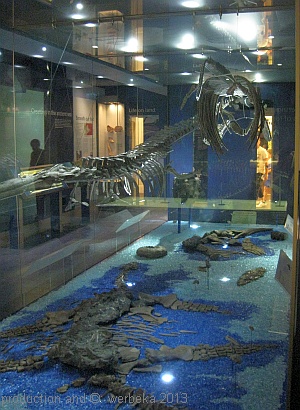 |
Eventually the landmass was hightened and, rather recently, the ice ages in the last few hundred thousand years scraped the surface, leaving a lot of gravel and sand behind. Between the ice ages, in the warmer periods (much warmer than today) there were elephants, rhinoceros and wild oxen strolling around Peterborough. Their remains were also buried and dug out in our days.
Many of the findings are exhibited in showcases and explanations are given on big poster boards. |
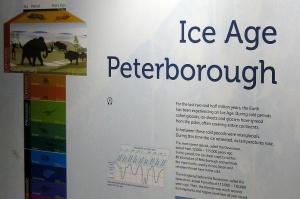 |
The exhibitions show then the first people living near Peterborough. In the stone age they were still hunters-gatherers and the main findings are stone hand axes and splinters of stone tools. Eventually, about 5000 years ago, more and more people settled as farmers, cultivating crops and rearing animals. Both activities required the lush forests to give way to acres and meadows. The first examples of pottery are shown, as well as pictures of round houses and settlements. The neolithic period gave way to Bronze and later Iron Age and civilization evolved even more. People were living in tribes and the Peterborough area was surrounded by the Catuvellauni, Corieltauvi and Iceni tribes. Of course there are various artefacts shown from the different eras, such as in the picture to the right.
During the Iron Age the area became more and more swampy - in 1950 an old prehistoric boat was found in the mud of the Nene river. |
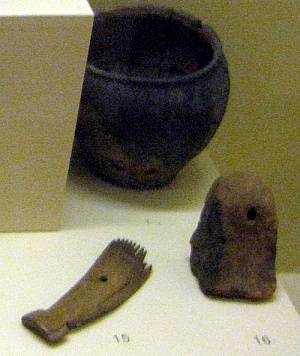 |
In the year 43 of our time the Romans invaded England. The main Roman north-south route in eastern Britain, The Ermine Street, ran through the area. At the crossing of the Nene a few miles upstream a fort was built. There was eventually a town growing, called Durobrivae (=fortress bridge). Probably it was a regional market centre. Roman villas were built and the museum gives a marvellous wallpainting of such an example (see the image below). Eventually there evolved a famous pottery industry in the Nene valley, the products of which were traded over all of Britain.
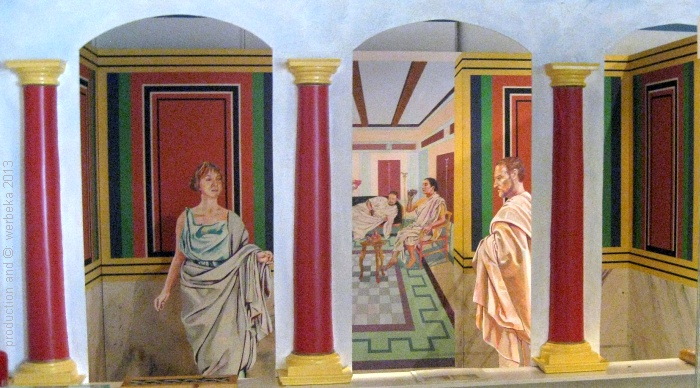
Both the town and the industry disappeared again, though, together with the Romans in the 5th century. After the fall of the Roman Empire there were the Anglo-Saxons to dominate the surroundings. One example of the Anglo-Saxon craftmanship is the "Hedda Stone" (see image below), that today can be seen in the Cathedral of Peterborough. Monks flooded the country and tried to convert people to christianity.
|
The area of Peterborough again lay between two important kingdoms, Mercia and East Anglia. It was the Mercians, who founded the abbey at Peterborough in the later half of the 7th century. This led to new settlements around the abbey and can thus be seen as the foundation of the town of Peterborough as well. During the following centuries the Vikings repeatedly raided the country. Some of them surely settled there as well, as we can see from certain names remaning. Scandinavisn "torp", meaning farmstead, and "holm", meaning small island, are examples.
|
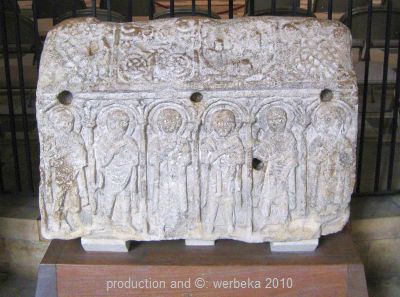 |
Talking about names: The town was originally called Medeshamstede, but got renamed to "Burh", in the 10th century. Compare the German "Burg", both meaning fortified places. Later it was called "Burh St. Peter", from which finally Peterborough developed. After the battle of Hastings, William the Conqueror's armies encountered rebellions throughout the country. Peterborough was destroyed in 1070. Rebuilt, it evolved to a medieval town and in Tudor times it got city rights.
During the Civil War soldiers of the Parliamentary side came to Petersborough to fight the Royalists nearby. But they also destroyed - as it happened so many times in history - cultural values, not at least the high altar and the choir stalls in the cathedral. In 1669 there was a public subscription raised for the building of a Town House on the Market Place. This is known today as the Guildhall (see picture). During the 18th century the city really prospered.
|
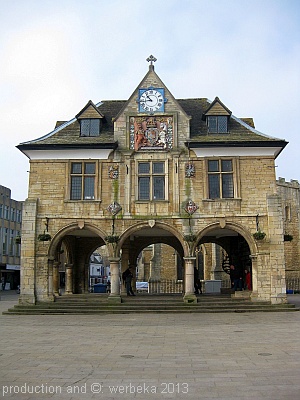 |
|
In 1797 a prison was built near Peterborough, mainly to keep the prisoners of the Napoleonic Wars. In the museum you can see a typical cell from that prison - there was really not much room for the prisoners. At most there were 7000 prisoners living there. The prisoners tried to make some money by producing casks and models from straw and bone.
|
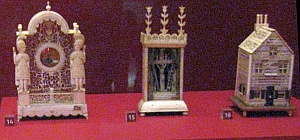 |
There is also a collection of prisonermade gadgets in the museum - some of them are amazing, considering the poor means the men had available for their production.
The last part of the exhibition is dedicated to "modern" times, the 19th and early 20th century. The Industrial Revolution and the railway (connecting Peterborough in 1845) are two important changes in this time. Brick-making became an important industry, due to a new method, making mass production possible.
It is also remembered, what the modern era meant for the household, with all its electric devices, stoves, washing machines, refrigerators, cooking aids and many others.
|
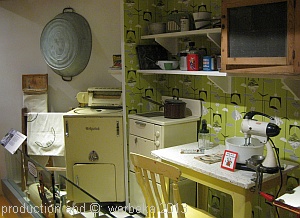 |
All this together makes it well worthwile, to spend a couple of hours studying the exhibitions, in order to learn about the evolution of Peterborough.
Copyright Bernhard Kauntz, Wolvertem 2013
Back to  or to the or to the  of of 
last update: 24.8.2013 by webmaster@werbeka.com
|










